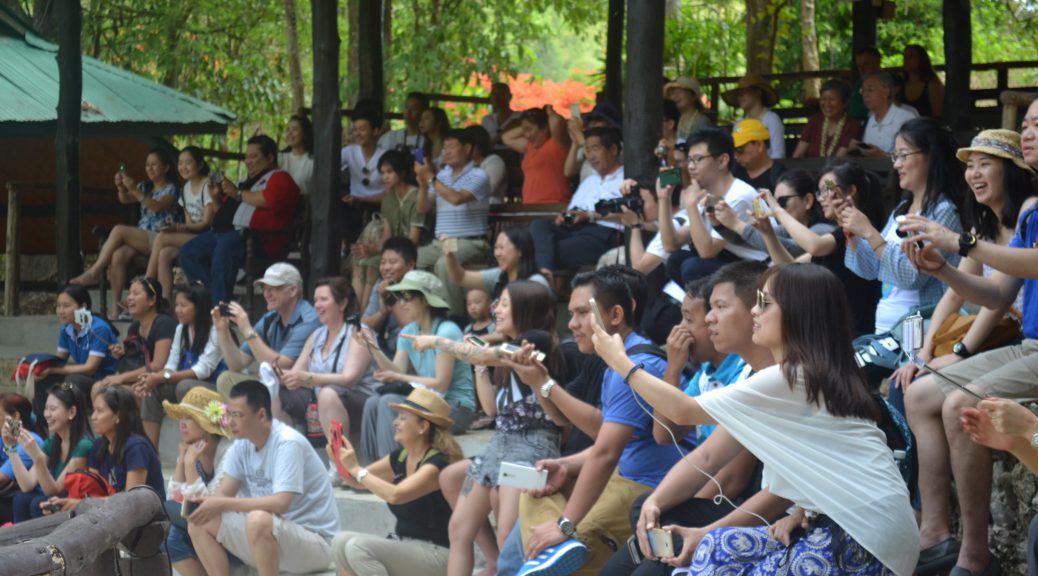Here is the link to the article Acharn Marina mentioned this afternoon when we discussed protection of indigenous design.
Monthly Archives: May 2016
A pinch of this, a pinch of that!
The first week of Thailand has been wonderful. I am continually amazed at how intentional Thai cuisine can be. On our first day in Chiang Mai, we learned how to cook Thai food. Each step and each ingredient had a specific purpose; the combination of sour, salty and sweet was a recipe for harmony for your taste buds! As we moved through the week, I start to see how Thailand’s economy is guided by food. Not only in the food we eat, but the growing process.
In Chiang Dao, the school was self-sustaining because they grew their own food. In the Hmong village, they developed the land to grow many types of fruits and vegetables and transition into organic growing. This change has helped to sustain the livelihood of the Hmong Tribe along with provide jobs and training for students and villagers. At the restaurants where we stopped to eat, many grew their own ingredients. The structure of the restaurants allowed for it to be a part of the natural environment. As we stroll through the city, a large percent of shops were restaurants, neighborhood were not taken up by big department stores.
A culture is very much reflective in their food. Thais cooks their food with meaning and purpose. Each ingredient is a note in the melody of the dish. It’ll be interesting to see what’s coming next in Chiang Rai.
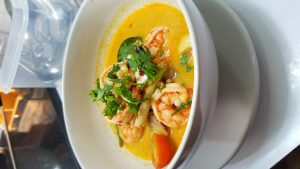
Beez In The Trap- Life as we know it
Thinking about what we have done so far in Thailand, my mind is bottled with so many thoughts– it has become quite challenging to process what life is like as a Thai person. In the lens of Acharn Linda’s nested model, I see the impact of all three society, natural/environmental world and economy.
From my observation, Bangkok and many aspects of cities such as Chiang Mai are becoming more commercialized and globalized. This can be seen in many forms. My first encounter to this is definitely upon the our arrival in Bangkok. Lavish city sky scrapers were everywhere and more were in progress of being built but contradicting this image were the impoverished homes, trash and construction surrounding them. I believe that due to the booming travel industry, many natural process of living in the city has been altered to accommodate the industry. The buildings and especially the marketing of ethnic cultures and their clothing. For example, it was not shocking to see Hmong patterned clothing and designs but to see it in almost every other vendor and almost in every clothing or good– was a little upsetting. I started to feel as though a part of my identity was being sold as commercialized good and that it’s value is as good as what it was sold for. Secondly, it felt as though these goods from different cultures (Hmong included) were exotic and often sough after since they were marketable and so many foreigners did not know who these different ethnic people were and what their traditional clothing and designs meant, it is just fashion.
The following picture is one capturing how ethnic cultural designs, patterns and clothing were utilized to make fashionable hand bags, earrings and necklaces all of which were sold in more than one market.
The gallery was not found!An additional piece to the travel industry, is the romanticized idea of elephants in Thailand. It became quite clear that foreigners love elephants regardless of race, age, sex or anything you can think of. I myself have become engulfed in this wave despite being aware to a certain extent. Below you will see that in Maesa Elephant Camp, Chinag Mai, the crowd bustling to see the many elephants. It is our interest and consumerism that allows globalizing of culture and traditions. Sometimes it is hard to see which part of this is truly traditional and cultural especially the relationship between an elephant and it’s Mahhut. While the relationship may be genuine, the intention is questionable.
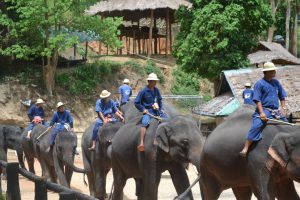
The few things I felt at ease watching was the sun setting after the monk chat in Wat Suan Dok. It felt so natural and calm after experiencing the busy city life. An interesting picture I captured was of the wooded pegs that were used to maintain the tree branches. I was curios to why they needed to maintain the tree branches when they can just let it grow naturally.
A calm culture
One of the most striking things I have noticed about the Thai culture is their calmness. Even among chaos and hard times they somehow manage to move through life at a comfortable pace, never seeming to focus too much about the past or the future, but on the present moment.
This became really apparent to me during our visit to the Hmong village. I felt a certain peace among the people while I was there. Even when the rain started to downpour they just rested for a while until it stopped, never seeing a setback as an inconvenience. They’re lives are very continuous, and not broken up into good or bad times. This relates to the Human Ecology Model, specifically the sociocultural aspect. Their calmness and sense of time can be seen as influencing one another in a harmonious way. I’ve observed that the “Thai time” moves slower than our fast paced way of life, which contributes to their sense of calmness. Another time I noticed this calmness and slower time urgency was during meal times. Since the Thai people take such pride in their cooking, it makes sense that they would place value on meal times.
The Thai’s calm nature is something that I hope to adopt in my own life and I can’t wait to see more examples of this play out in the next couple of weeks.
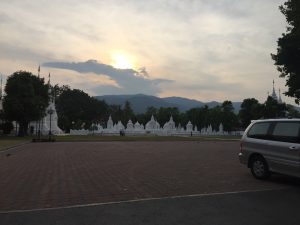

Community and Poverty
Community and Poverty
Coming to Thailand, I was amazed by the great sense of community that I saw. From everywhere, to the School, the elephant camp, the Hmong village and the Elder Home. This sense of community really spoke to me because it’s not something I see often in the states. It’s also something I miss seeing. Growing up in Guyana, there was always a sense of community and strong bonds with families, neighbors and villages. I was very excited when I saw that sense of community here because it reminded me of home and it reminded me of my own values. When we were at the Elder home and they were talking about reasons for these elders to end up there, one of the reason was because they were abandoned. I can’t imagine what kind of person could and would do that to their own parents. Especially if the come from a culture that values community so much. That was one thing that really stuck out to me and just stayed in my head through out the day. It made me think about what if that were my parents, I could never imagine myself abandoning my parents. That experience just made me think a lot about how I let over community, especially within my family.
Another thing I noticed about community is that Thai people, as well as the different ethnic are very welcoming and caring people. From walking down the streets, to the hotel staff, going to the school, village and elder home, everyone has made us feel welcomed. When the students at the school took time to prepare our lunch for us, I thought that was amazing. Their hospitality towards strangers was something I admired. I especially appreciated how welcomed I felt in the Hmong village. I know that the Chief, and whom I believe was his sons, and the other folks that were showing us around and helping us out, they took time out of their day to accommodate us. I’m sure they had other things to do, like their jobs or helping out to take care of other things around the village. I just found it amazing how great everyone in this country has been towards us, and how inclusive they have been.
One thing I absolutely loved was that though there’s so much poverty here, an example is the school and the Hmong village, the children were so happy, they were carefree and just enjoying themselves. Seeing that makes me so happy because since I was once that child. But since I’ve been in the US, I became so dependent on material things that I forget about how much happiness can come from just the very simple things in life. Seeing the joy in these kids, I’m amazed and it also helps me reflect on my life and I think about all the things I take for granted. They have inspired me so much that I’m already thinking about ways to lessen myself of material things when I go back to the states.
Overall, one main thing I’ve noticed is that poverty and community is something that’s very intertwined. In the places with more poverty there’s more community which is something that makes me think about us as a society and our own values
#2 – The Natural Environment
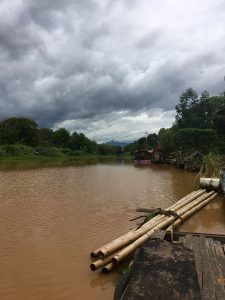 Thailand, for me, has been an opportunity for observation and comparison. I would like to stress that I am not focusing on judgmental comparisons, but instead constructive analyses between two very different cultures, the Thai and the American, in order to benefit from one another. In particular, my observations have been geared towards the natural environment and how the human built environment in working with it as well as against it. Looking out the window is where I notice the most, but also walking by and being among it all. I remember Acharn Linda saying, when we were all sharing our first impressions, that the Thai intentionally or even unconsciously maintain these “green spaces” throughout their infrastructure and within their built environments. I took notice to this as well, and I continue to see it as we travel around this country.
Thailand, for me, has been an opportunity for observation and comparison. I would like to stress that I am not focusing on judgmental comparisons, but instead constructive analyses between two very different cultures, the Thai and the American, in order to benefit from one another. In particular, my observations have been geared towards the natural environment and how the human built environment in working with it as well as against it. Looking out the window is where I notice the most, but also walking by and being among it all. I remember Acharn Linda saying, when we were all sharing our first impressions, that the Thai intentionally or even unconsciously maintain these “green spaces” throughout their infrastructure and within their built environments. I took notice to this as well, and I continue to see it as we travel around this country.
They seem to incorporate natural features into their city planning. For instance, the sidewalks (or more-so roadside curbs) have trees in the midst or their concrete slabs. Instead of bringing down the tree, which commonly occurs in American construction, the Thai value its presence and work around it. This is a minor aspect that I believe would be beneficial in American society in order to better preserve our natural environment.
I have also taken great notice to the water. This, through my observations, is not as thoroughly protected in Thailand. In Bangkok, their streams are not at all in their natural form and are instead surrounded by concrete which molds their pathway. This is where the human built environment in Thailand has controlled the natural one and, in this case, has restricted biodiversity. The water is not able to interact with vegetation that aids so significantly in its quality, as well as for any aquatic species that may be lurking in these waterways. In the city of Chiang Mai, it is a bit different. Green spaces do exist along the waters edge, which I love to see, but this led me to observe other aspects of the Thai’s water. The most profound, the brown, murky appearance (which is not necessarily bad) as well as the abundant liter present in many areas. The brown color is due to the soil and sediments in the river, especially due to intense rainfalls that are so common in Thailand and can sweep away much of the landscape. This is not directly linked to its poor quality, but instead turns people away, especially in reference to the views of the American, from considering it to be potable. The final aspect I will conclude with is the sanitation of the river that has been negatively impacted by the human built environment as well as some social and cultural norms here in Thailand. This is where my interest lies, however I am not yet significantly knowledgeable on the topic, especially in Thailand, but I have been intensely observing and comparing. The trash and lack of sanitation is very prevalent, but I believe the Thai people are not to directly blame. As Acharn Cathy considered, it is quite possibly the infrastructure and/or economy that is preventing sanitation from being the people’s main priority. Globalization is forcing Thailand to accommodate more people, and, especially in the city, the garbage has no where else to go. I believe this is an area where Thailand and its natural environment could prosper from implementing some aspects of America’s intense sanitation procedures into their society.
Personally, I will continue to observe my surroundings and compare it to the one that is familiar to me in order to take back with me ideas and values that I can consider throughout my life and future work. The two cultures have the capability of growing from one another in many ways. We are able to gain an appreciation for the natural environment and our reliance on its provided resources, whether it be for oxygen, water, food production, or simply its beauty.
Little reminders while in Thailand

As I reflect on my experience at the Pha Nok Kok hmong village in Chiang Mai. I noticed that there is a similarity between the Hmong names in America and Thailand. As an Hmong American women I have two names–Hmong and English. My name is Shengyeng . The Hmong spelling of my name is Seev Yees. I also have an American name as my middle name which is Emily. Growing up it was easier to pronounce Emily in grade school, so I went with that name. It didn’t bother me much, because it was easier to write. However, I felt like a piece of me was missing. I’m still on the journey to find that missing piece.
During the discussion with the Chief of the Village I was curious about why the Hmong Thai have a Thai name. I learned about this in a recent Hmong movie that I watched. I never knew the reason why the Hmong Thai people changed their names to Thai. I wasn’t sure if they kept their Hmong name. It wasn’t until the Chief explained that ‘Thai’ is a Universal language. Since they live in Thailand it was easier to understand Thai. In order to adapt in the Thai culture they must have a Thai name, but still have their Hmong name. In addition, he even mention that sometimes nick names are given. With this explanation from the Chief I was reminded of my own name in America. I now have a deeper appreciation of my name whether it’s in Hmong or American.
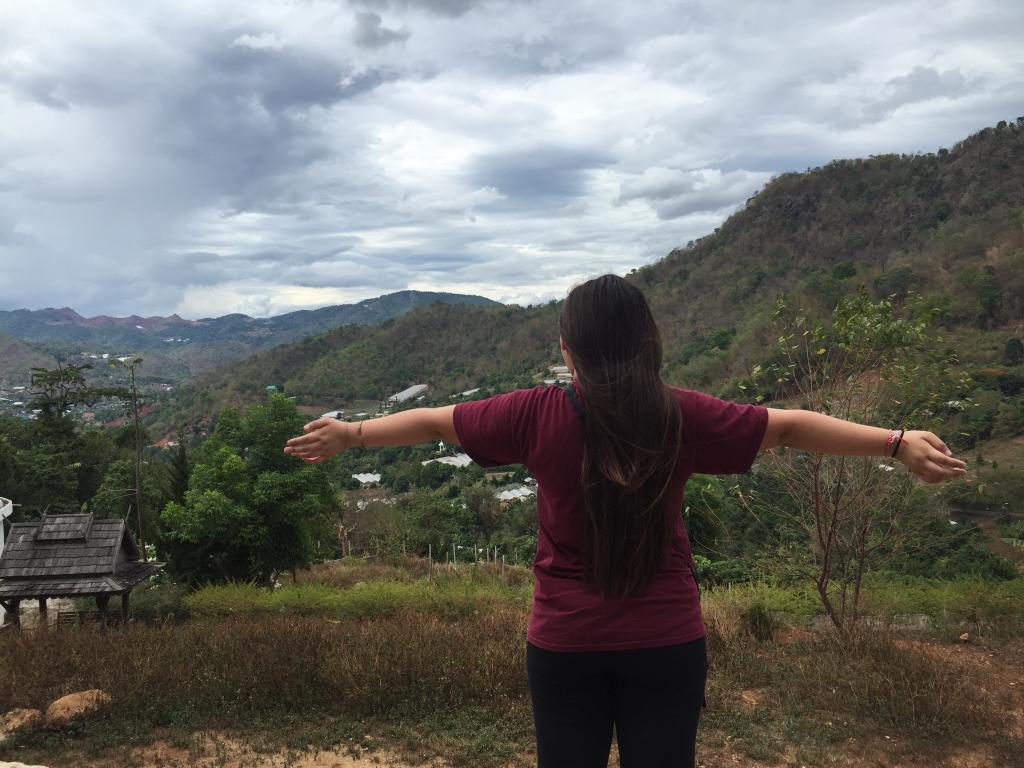
As I got older I find myself using the name Shengyeng more and more. Sometimes I feel self-conscious using the correct pronounciation to others. However, over the years I had learn to embrace my first name in Hmong. I prefer for everyone to call me by my name Shengyeng. I believe that a person’s name is their brand. It should be carried with pride and corrected if misprounced by others. It wasn’t until I graduated from High School that I was reminded of the importance of my name.
Another experience was from the “What is your name?” activity with the High School students at Chiang Dao School This was definetely a reminder to listen. Just as Eve explained about the different languages and cultures. What I took away from the activity is that listening is important when there’s a language barrier. I had trouble learning the name of the Thai students, but with our body language and hand signals it definitely helped. I truly believe that language plays an important part in life. As Acharn Cathy mentioned from our debrief discussion, “language creates stronger relationships’.
In a nutshell, these experiences will help me grow and shape me as an individual.
Blog Post #2 — Lizzy
An overarching theme that keeps coming to my mind during this trip is the dichotomy between the environment and society. As a Buddhist culture, Thai culture greatly values the natural world and all of its beings. However, I have noticed that in both city and hillside, the filth is exceptional. I wonder where the disconnect is between the Buddhist way of caring for the Earth and the reality of Thai culture’s practice of environmental care.
Something that surprised me is that I have not seen any campaigns or signs for being “green” or environmental well-being like we often see in America. In parallel to the lack of social action, there is very limited infrastructure in place to help promote “green-living.” I have noticed that they only fly large planes here and that they often fly at half capacity. I have noticed that the number of cars and motorcycles/scooters far outnumber the number of bicycles or people walking. I have noticed that the streets are full of trash and that the only cleanly sidewalk that I’ve walked on thus far is our hotel’s.
I think that the lack of environmental effort here is rooted in larger-scale developmental and governmental progress because no country would, or could, prioritize environmental issues over high rates of poverty and homelessness. Lastly, I recognize that my perspective is severely skewed by my privilege of growing up in a country that has the ability to make environmental well-being a priority and that my observations are by no means shaming the Thai culture. I believe that many people are in a position of privilege to help preserve our environment and that we should do everything in our power, so those who are less fortunate can live on the Earth too.
Oddly enough, I haven’t taken any pictures of the filthy streets… So here are some pictures of how beautiful Thailand is (plus me and an elephant)!
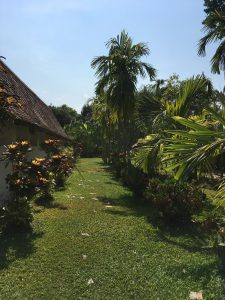

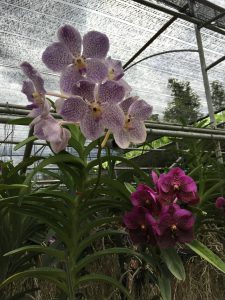
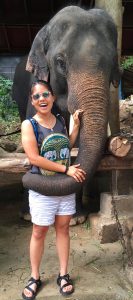
Blog #2 – Balance and Harmony
Balance and harmony permeate several aspects of Thai culture, shaping the people, environment, and my experience of Thailand.
This first came to my attention earlier in the semester when Acharn Cathy talked about how people smile a lot in Thailand and avoid showing anger in order to preserve harmonious relationships with others. Being in Thailand now, I have seen how these social norms play out. I’ve noticed how the drivers of our vans remain very outwardly calm as they drive through the city, even if someone cuts them off or drives too close to them. Of course there are exceptions, like a few times when a driver gave a quick and gentle “beep” to other drivers, but for the most part they haven’t expressed a lot of anger or road rage.
 Meals are also crafted in a way that embodies balance and harmony in both their flavors and presentation. When we went to the Thai cooking school, the woman who was teaching us made sure to identify the flavors in each dish and how they interacted with each other, and the way she arranged her food on the plates was visually appealing. I’ve noticed similar food aesthetics in the other places we’ve eaten too, like the Garden Cafe.
Meals are also crafted in a way that embodies balance and harmony in both their flavors and presentation. When we went to the Thai cooking school, the woman who was teaching us made sure to identify the flavors in each dish and how they interacted with each other, and the way she arranged her food on the plates was visually appealing. I’ve noticed similar food aesthetics in the other places we’ve eaten too, like the Garden Cafe.
Finally, I’ve noticed how the presence of nature is welcomed into many of the indoor spaces we’ve visited. For example, the cooking school had very few walls, which allowed for bugs and geckos to freely move between the cooking area and the outdoors. We also went to the Chiang Dao school where we spent a lot of the afternoon in a gymnasium with huge arches leading to the outside
I have really enjoyed experiencing Thai culture, and I look forward to learning more over these next two weeks.
How to be a Tourist in Thailand
I have the amazing opportunity to be able to be in this country after learning a little about Thai culture from the orientation we had. As well as being surrounded with peers and teachers who are so knowledgeable. Knowing what little I knew of Thai culture before coming here has helped me to observe more clearly. I have noticed the kind natured and very generous culture show through since arriving. This was something I wasn’t used to and it brought a lot of questions to mind.
I been very interested in how the high population of tourists has affected this welcoming culture that is present. This curiosity has come about from everything, my bags being carried up to my room for me, my food brought out, or the wooden pieces of the game in the Hmong village being retrieved for us. I cannot help but wonder if this is purely for cultural reasons or if it has some effects of tourism within it.
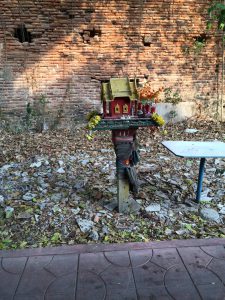
The fact that I couldn’t help but assume that there was more to this country or their culture than met the eye has made me reflect on my own culture as well. I am used to Minnesota nice, where people say what they know you want to hear rather than the truth. I also come from America where it is largely encouraged to question and change things constantly. These ideas have made me think that the there must be more to why the people in Thailand are so generous, that it must be because we are paying them and not because it is a cultural norm.
Now if you lump all tourists into one category and ask; does this affect the culture here in Thailand? I would say yes. We bring with us these expectations of an unforgettable time and our fast paced ideals that are usually linked with more developed countries. I think that this has caused the more competitive nature in the markets, the night markets and late night things always going on. For a simple culture this can change locals daily lives. One example is the children of street vendors who cannot find someone to watch their kids, they stay out late with their parents and this may disrupt the norms of each individual family.

